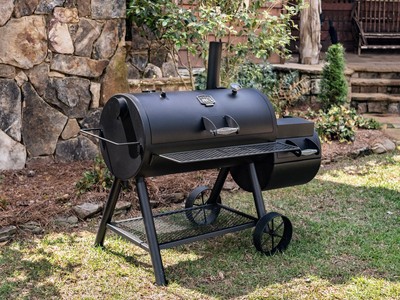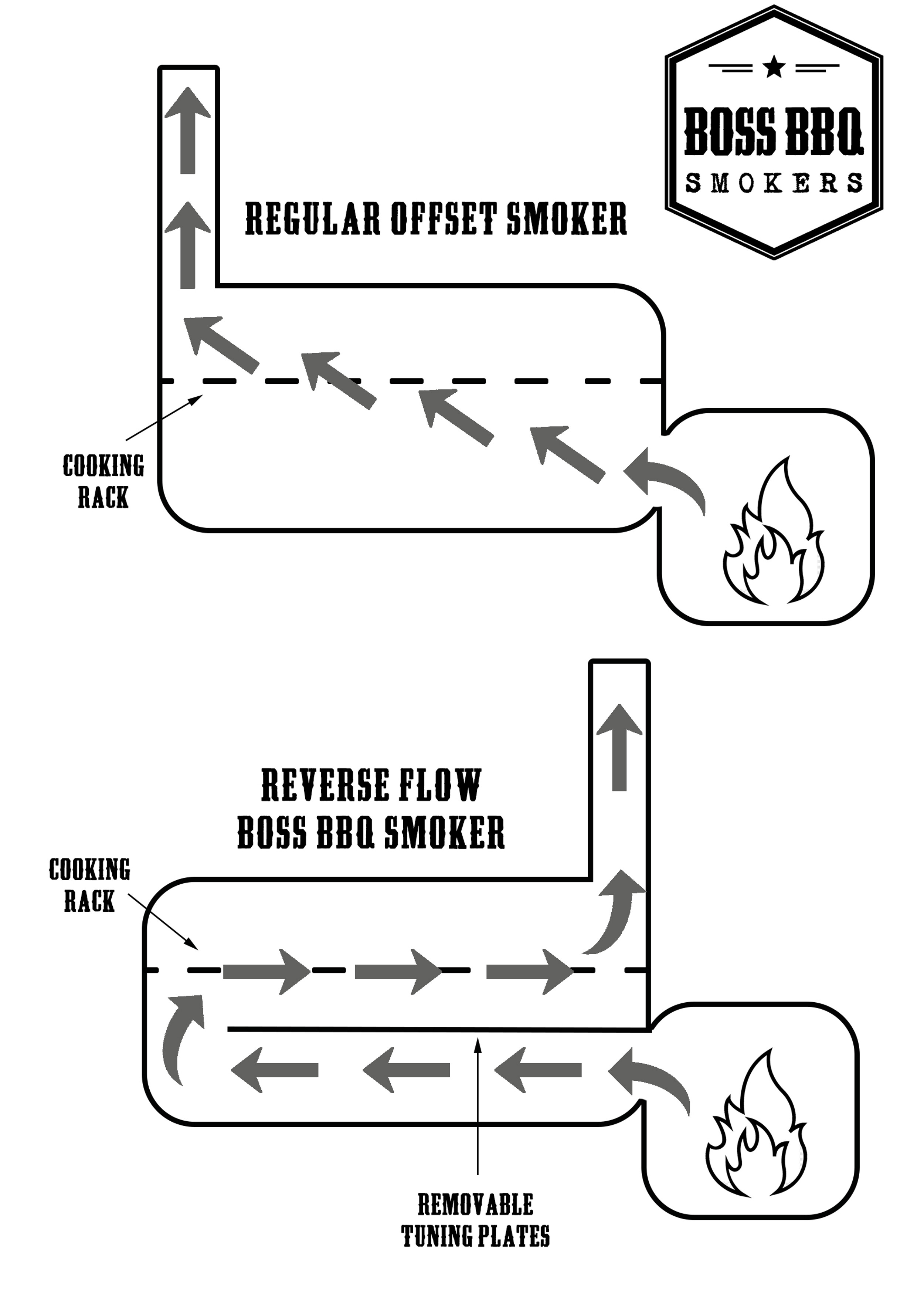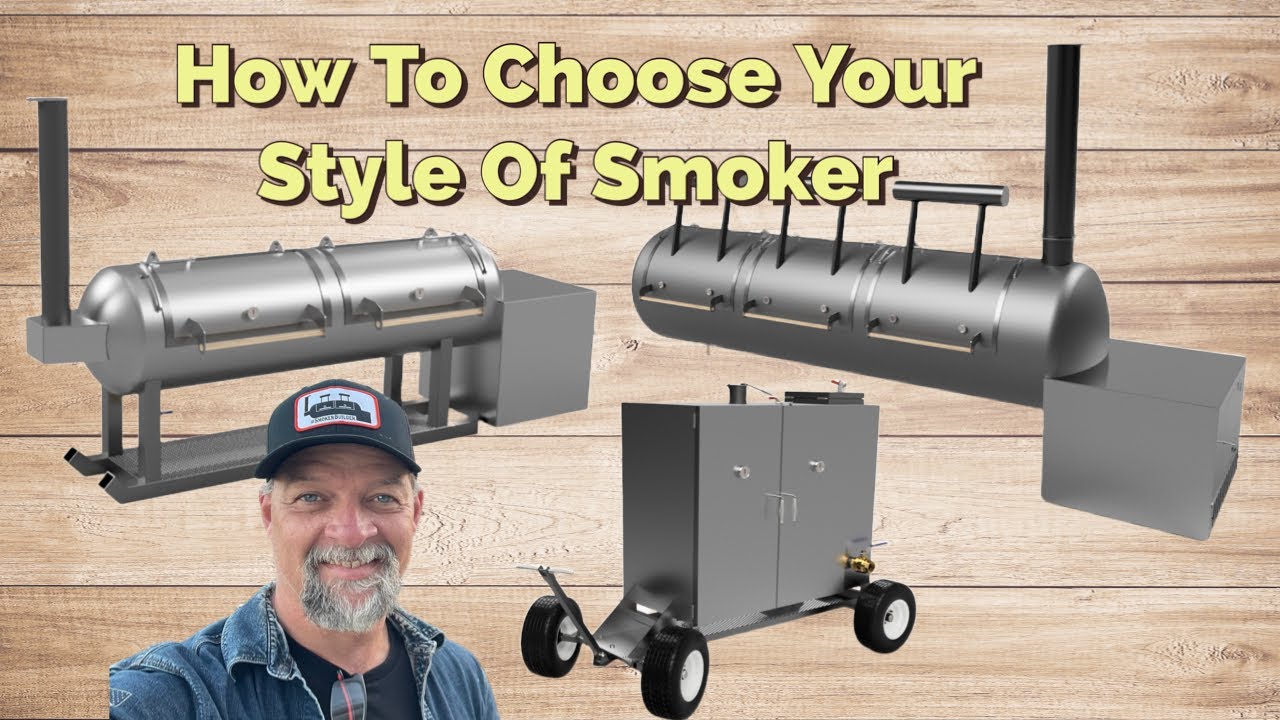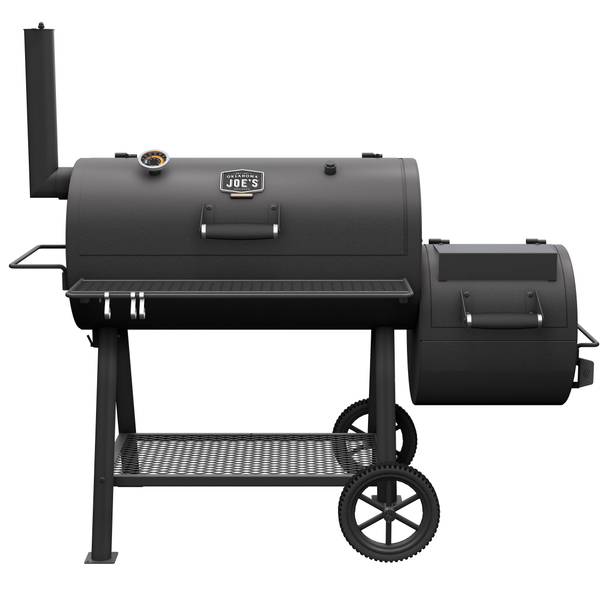Understanding Reverse Flow Smokers And Offsets

Reverse flow smokers and offset smokers are two popular types of smokers that are commonly used for barbecuing and smoking meats. While they may look similar at first glance, they have distinct differences in terms of how they work and the results they produce.
Reverse flow smokers are designed with a baffle system that forces the smoke to flow in a reverse direction before exiting the cooking chamber. This ensures that the heat and smoke evenly distribute throughout the chamber, resulting in more consistent cooking temperatures and a more even smoke flavor on the meat.
On the other hand, offset smokers have a separate firebox attached to the side of the cooking chamber. The smoke and heat from the firebox enter the chamber through a small opening, creating a direct heat source that can be controlled by adjusting the airflow and adding more fuel to the firebox.
These differences in design and functionality affect the cooking process and the flavors achieved. Reverse flow smokers tend to provide a more even heat distribution and a milder smoke flavor, while offset smokers offer more direct heat and a stronger, smokier flavor.
When choosing between a reverse flow smoker and an offset smoker, it’s important to consider your personal preferences and cooking style. If you prefer a more controlled and consistent cooking environment, a reverse flow smoker may be the better option. However, if you enjoy the traditional smoky flavors and don’t mind a bit of variability in temperature, an offset smoker might be the perfect choice.
Regardless of which type of smoker you choose, both reverse flow smokers and offset smokers can produce delicious barbecue and smoked meats. It ultimately comes down to personal preference and mastering the art of smoking. So, whether you’re a professional pitmaster or a backyard barbecue enthusiast, understanding the differences between these smokers will help you make an informed decision and elevate your smoking game.
Reverse Flow Smokers: How They Work
Reverse flow smokers are designed with a unique baffle system that sets them apart from traditional offset smokers. The baffle, located inside the cooking chamber, forces the smoke and heat to travel in a reverse direction before exiting the chamber through an opening near the chimney. This reverse flow of smoke and heat ensures that it passes over the meat multiple times, resulting in a more even distribution of heat and a milder smoke flavor. The baffle also helps to prevent hot spots and promotes consistent cooking temperatures throughout the smoker. Overall, reverse flow smokers provide a controlled and efficient cooking environment for delicious barbecued meats.
Offset Smokers: Overview And Functionality
Offset smokers, also known as traditional offset or Texas-style offset smokers, are a popular choice among barbecue enthusiasts. They feature a classic design with a firebox attached to the side of the cooking chamber. The heat and smoke from the firebox flow into the cooking chamber, cooking the meat indirectly. The offset design allows for better heat control and smoke circulation, resulting in a distinct smoky flavor. These smokers are versatile, allowing you to cook a variety of meats simultaneously. However, they require more attention and monitoring to maintain consistent temperature and avoid hot spots. Overall, offset smokers provide a traditional smoking experience and are perfect for those who enjoy the hands-on approach to barbecue cooking.
Benefits Of Reverse Flow Smokers And Offsets

Reverse flow smokers and offset smokers each offer their own unique benefits.
Reverse flow smokers have the advantage of providing consistent heat distribution and even cooking. The reverse flow design allows the smoke and heat to flow over the meat before exiting through the chimney, resulting in tender and flavorful barbecue. Additionally, the reverse flow design helps to prevent hot spots and reduces the risk of flare-ups.
On the other hand, offset smokers provide a traditional smoking experience and allow for greater versatility. They offer a larger cooking surface and the ability to cook different types of meats simultaneously. Offset smokers also provide better control over the smoke flavor and allow for adjustments to be made to the fire and airflow.
Ultimately, the choice between a reverse flow smoker and an offset smoker will depend on personal preferences and the desired smoking experience.
Advantages Of Using A Reverse Flow Smoker
Using a reverse flow smoker offers several advantages. Firstly, the reverse flow design ensures consistent heat distribution, resulting in even cooking. This eliminates the need for constant monitoring and intervention from the cook, making it a convenient option. Additionally, the reverse flow design allows the smoke and heat to flow over the meat before exiting through the chimney, infusing it with a delicious smoky flavor. Furthermore, the reverse flow design helps to prevent hot spots and reduces the risk of flare-ups, ensuring the meat is cooked evenly and to perfection. With these benefits, a reverse flow smoker is a great choice for achieving tender and flavorful barbecue.
Benefits Of Using An Offset Smoker
Using an offset smoker offers several benefits. Firstly, the offset design allows for greater control over the cooking process. The separation of the firebox and the cooking chamber ensures that the heat is indirect and evenly distributed, resulting in a more consistent cooking temperature. Additionally, the offset smoker allows for larger cooking capacities, making it suitable for cooking for larger groups or events. The offset design also allows for the option to add wood chips or chunks directly to the firebox, enhancing the smoky flavor of the meat. Overall, using an offset smoker provides flexibility, control, and the ability to achieve delicious barbecue.
Features To Consider

When selecting between a reverse flow smoker and an offset smoker, there are several features to consider.
For reverse flow smokers, it is important to look for key features such as a welded baffle plate, which helps to distribute heat evenly and produce consistent results. Another important feature is the size of the firebox, as a larger firebox allows for better heat control.
When considering offset smokers, important features to look for include the thickness of the steel, as a thicker steel helps to retain heat and maintain a consistent temperature. Additionally, the size of the cooking chamber should be considered, as a larger chamber allows for more cooking capacity.
Overall, selecting the right features based on your specific needs and preferences will ensure that you choose the perfect smoker for your cooking requirements.
Key Features Of Reverse Flow Smokers
Reverse flow smokers have several key features that set them apart from other types of smokers. One important feature is the presence of a welded baffle plate. This plate helps to distribute heat evenly throughout the cooking chamber, ensuring consistent cooking results. Another key feature is the size of the firebox. A larger firebox allows for better heat control, giving the cook more options when it comes to adjusting the temperature. Additionally, reverse flow smokers often have a larger cooking chamber, providing ample space to cook large quantities of food. These features make reverse flow smokers ideal for those who value consistent results and the ability to cook large batches of food at once.
Important Features To Look For In Offset Smokers
When selecting an offset smoker, there are a few important features to consider. First and foremost, pay attention to the thickness of the metal body and cooking chamber door. Good quality offset smokers are built with thick, durable metal that helps retain heat and maintain consistent temperatures. Another feature to look for is a sturdy construction, including strong legs and hinges that can withstand the weight of the smoker and provide stability. Additionally, it’s beneficial to choose an offset smoker with adjustable dampers, as these allow for better control over airflow and temperature regulation. Finally, consider the size of the cooking chamber to ensure it can accommodate your cooking needs. By paying attention to these important features, you can find an offset smoker that delivers excellent performance and durability.
Maintenance And Cleaning

To ensure the longevity and optimal performance of your smoker, regular maintenance and cleaning are essential. For reverse flow smokers, it’s important to inspect and clean the baffle plates and cooking grates to remove any grease buildup or residue. Additionally, check for any signs of rust and treat the affected areas accordingly. As for offset smokers, pay attention to cleaning the cooking chamber, removing any ashes or debris, and inspecting the firebox for any signs of wear. Proper maintenance also includes lubricating hinges and cleaning the chimney to ensure good airflow. By following these maintenance practices, you can enjoy consistent and flavorful results from your smoker for years to come.
Maintenance Tips For Reverse Flow Smokers
To keep your reverse flow smoker running smoothly and maintain its optimal performance, regular maintenance is key. Here are some essential maintenance tips to follow:
- Clean the baffle plates and cooking grates regularly to remove any grease buildup or residue. This will prevent any flavor contamination and ensure even heat distribution.
- Inspect the smoker for any signs of rust or corrosion. If you notice any, treat the affected areas with a rust remover and apply a high-heat paint to protect the smoker from further damage.
- Lubricate the hinges and check for any loose or worn-out components. Proper lubrication will ensure smooth operation and prevent any unnecessary friction.
- Clean the chimney regularly to ensure good airflow. A clogged chimney can hinder the heat and smoke distribution, resulting in uneven cooking.
By following these maintenance practices, you can extend the lifespan of your reverse flow smoker and enjoy delicious meals every time you use it.
Cleaning Guide For Offset Smokers
Cleaning an offset smoker is an important part of maintaining its performance and prolonging its lifespan. Here is a quick and easy cleaning guide for offset smokers:
- Start by removing any leftover ashes and debris from the firebox and cooking chamber. Use a brush or scraper to get rid of any stubborn residue.
- Next, clean the cooking grates by scrubbing them with a grill brush. This will remove any leftover food particles and grease buildup.
- If your offset smoker has a removable ash drawer, empty it and clean it thoroughly to ensure proper airflow.
- Wipe down the exterior of the smoker with a damp cloth or sponge. This will remove any dirt or grease that may have accumulated.
- Lastly, check and clean the chimney and vents to ensure good airflow. Use a chimney brush to remove any creosote buildup.
By following these simple cleaning steps after each use, you can keep your offset smoker in great condition and enjoy delicious smoky flavors every time you cook.
Which One To Choose?

When it comes to choosing between a reverse-flow smoker and an offset smoker, it ultimately depends on your personal preferences and cooking style. If you value even heat distribution and lower fuel consumption, a reverse-flow smoker may be the better choice for you. On the other hand, if you enjoy the traditional cooking experience and don’t mind tending to the fire and managing the temperature, an offset smoker might be more suitable. Consider factors such as cooking capacity, ease of use, and budget to make the best decision for your smoking needs.
Factors To Help You Decide Between Reverse Flow And Offset Smokers
When deciding between a reverse flow smoker and an offset smoker, there are several key factors to consider. Firstly, think about your cooking preferences. If you prefer a more hands-on approach with the ability to tend to the fire and manage the temperature, an offset smoker might be the right choice for you. However, if you value even heat distribution, lower fuel consumption, and a set-it-and-forget-it cooking style, a reverse flow smoker may be more suitable. Additionally, consider factors such as cooking capacity, ease of use, and budget to make the best decision for your smoking needs.
Comparison Of Reverse Flow Smokers And Offset Smokers
When comparing reverse flow smokers and offset smokers, it is important to consider their key differences.
Reverse flow smokers provide even heat distribution by forcing the smoke and heat to travel through a baffle system, ensuring that every part of the smoker receives consistent cooking temperatures. On the other hand, offset smokers rely on the natural flow of smoke and heat to cook the food, which can result in hotter temperatures near the firebox and cooler temperatures farther away.
Furthermore, reverse flow smokers require less fuel consumption due to their efficient design, while offset smokers may require more fuel to maintain the desired temperature.
In terms of temperature control and ease of use, reverse flow smokers are preferred by many as they offer a set-it-and-forget-it cooking style. Offset smokers, however, require more attention and manual adjustments to maintain the temperature.
Additionally, reverse flow smokers often have a larger cooking capacity compared to offset smokers, making them a better choice for those who plan to cook for larger groups or events.
When it comes to budget, offset smokers tend to be more affordable, while reverse flow smokers are usually pricier due to their advanced design and features.
Ultimately, the decision between reverse flow smokers and offset smokers depends on personal preferences, cooking style, and budget.
Conclusion

In conclusion, choosing between a reverse flow smoker and an offset smoker ultimately depends on your specific needs and preferences. If you prioritize even heat distribution and consistent cooking temperatures, along with a larger cooking capacity, then a reverse flow smoker may be the right choice for you. On the other hand, if you prefer more flexibility in cooking different types of meats and are comfortable with manual temperature adjustments, an offset smoker can still deliver excellent results. Consider factors such as fuel consumption, temperature control, and budget when making your decision.
Making The Best Decision For Your Smoking Needs
When it comes to selecting the perfect smoker for your needs, it’s important to consider your specific preferences and requirements. Both reverse flow smokers and offset smokers have their own set of advantages and considerations.
If you prioritize even heat distribution and consistent cooking temperatures, along with a larger cooking capacity, then a reverse flow smoker may be the right choice for you. The reverse flow design helps to ensure that the smoke and heat circulate evenly throughout the cooking chamber, resulting in more uniform cooking.
On the other hand, if you prefer more flexibility in cooking different types of meats and are comfortable with manual temperature adjustments, an offset smoker can still deliver excellent results. Offset smokers allow for greater control over the cooking process, as you can adjust the placement of the firebox and regulate the airflow to achieve the desired temperature.
Consider factors such as fuel consumption, temperature control capabilities, and budget when making your decision. It’s also helpful to read reviews and seek recommendations from fellow smokers or experts in the field. Ultimately, choosing between a reverse flow smoker and an offset smoker depends on your personal cooking style and preferences.
Remember to take into account the features, maintenance requirements, and cleaning processes when comparing the two options. By carefully considering your smoking needs and doing your research, you can make an informed decision and choose the perfect smoker that will enhance your outdoor cooking experience.
FAQ About Reverse Flow Smoker Vs Offset: Selecting The Perfect Smoker
Q: What is a Reverse Flow Smoker?
A: A Reverse Flow Smoker is a type of offset smoker that uses a baffle system to guide the smoke and heat underneath the cooking chamber before it enters and flows back over the meat, ensuring even heat distribution and reducing hot spots.
Q: What is an Offset Smoker?
A: An Offset Smoker is a traditional smoker design where the firebox is located beside or below the cooking chamber. Smoke and heat travel horizontally through the cooking chamber, indirectly cooking the meat.
Q: What are the advantages of a Reverse Flow Smoker?
A: Some advantages of a Reverse Flow Smoker include more even heat distribution, reduced hot spots, enhanced smoke flavor infusion, and typically easier temperature control.
Q: What are the advantages of an Offset Smoker?
A: An Offset Smoker is known for creating authentic barbecue flavor, allowing for larger cooking capacities, versatility in fuel options, and a traditional smoking experience.
Q: How do I choose between a Reverse Flow Smoker and an Offset Smoker?
A: When selecting between a Reverse Flow Smoker and an Offset Smoker, consider factors such as desired flavor profile, cooking capacity needed, budget constraints, ease of use, and cooking experience level.
Q: Which type of smoker is easier to maintain?
A: Generally, Reverse Flow Smokers are easier to maintain due to their design that helps prevent creosote buildup and provides more consistent heat distribution. However, regular cleaning and maintenance are crucial for both types of smokers to ensure optimal performance.

Johnny Knuckles Knock-out BBQ is a culinary haven for barbecue enthusiasts, offering a fusion of traditional BBQ and tantalizing street fare. Our secret to delivering mouthwatering dishes lies in our meticulous preparation process. Each cut of meat is lovingly hand-rubbed and slow-smoked over 100% hardwood, creating a symphony of flavors that will leave your taste buds dancing. Whether planning a special event or simply craving an unforgettable meal, Johnny Knuckles Knock-out BBQ is here to elevate your dining experience. Our catering services are designed to bring the sizzle and aroma of our delectable BBQ to your event, ensuring that every guest leaves with a full belly and a smile.